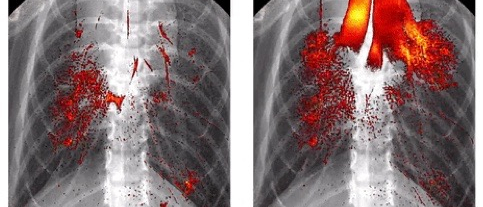Zur deutschen Version der Meldung
Scientists at the Helmholtz Zentrum München and the Munich School of BioEngineering (MSB) at the Technical University of Munich (TUM) have presented a combination of imaging techniques that allow real-time monitoring of the delivery of inhaled drugs within the lungs of mice and their absorption in the lung tissue. The results are intended to guide the development of high-efficacy drugs with fewer side effects for treating human lung diseases. The Munich Compact Light Source (MuCLS), a unique, compact particle accelerator that generates high-brilliance X-rays, was used to make the measurements at the MSB. The researchers reported their results in the journal SMALL.
Drugs inhaled by patients are well established as effective treatments for lung diseases such as chronic obstructive pulmonary disease (COPD), asthma or infections. In the future, other drugs might be administered in this way – for example cancer medications in which the effective ingredient is contained in nanoparticles. "Nanoparticle-based drugs have many advantages," says Otmar Schmid, who heads a working group at the Institute for Lung Biology and Disease at the Helmholtz Zentrum München. "For example, the effective ingredients cannot be broken down as easily by enzymes because they are embedded in the nanoparticle. The nanoparticles can also target the diseased cells more specifically by attaching ligands that dock onto them." This would mean a more focused delivery of the effective ingredient to the diseased tissue, which would significantly reduce the side effects.
Researchers in Otmar Schmid's working group have now teamed up with colleagues at the Munich School of BioEngineering (MSB) at TUM to present a combination of imaging techniques that can show in detail how the delivery of a drug in the lung of a mouse depends on the way the drug is administered. The results of such studies are intended to provide important insights for the development of lung medications for humans.
Lung filmed at particle accelerator
The TUM researchers contributed two techniques that use X-rays. With one of the techniques, they were able to record video images showing how drugs inhaled by a mouse spread from the air tube throughout the lung in real time. The other technique generated 3D images of the entire lung. Instead of administering a real drug, they used a solution containing nanoparticles, but with no active ingredient, mixed with an iodinated medical contrast agent that is clearly visible in X-ray images.
The researchers produced the film using X-ray images of the mouse lung taken at the same point in the breathing cycle. "By using the propagation effect of the X-rays, we were able to create a clear visualization of the tissue structures in the lung," says Regine Gradl, who performed the measurements at the MSB as part of her doctoral research at the TUM Chair of Biomedical Physics. "In conventional X-ray images, we would not have seen much more than the ribcage and the iodinated contrast agent." The propagation effect uses the fact that the X-rays are slightly deflected as they pass through the sample under investigation, which can cause interference between some of the rays behind it. These interference effects reveal additional details in the X-ray image, in particular at the borders of soft tissue, for example where air meets lung tissue.
